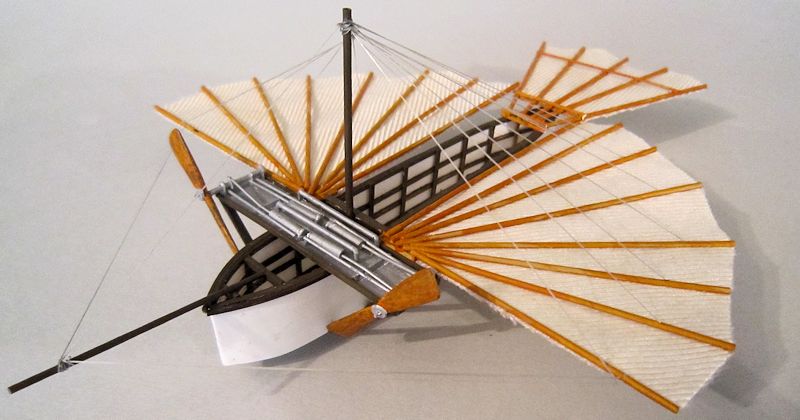
| KIT #: | |
| PRICE: | $ |
| DECALS: | |
| REVIEWER: | Chris Peachment |
| NOTES: |
Ten and 20 thou plastic card, rod, strut, and an
old silk opera scarf.
|

| HISTORY |
It is possible that this machine was the first heavier than air aircraft to
achieve powered flight in 1901, some two years before the Wright Brothers
managed it. The record sharply divides aviation authorities, and it is an
argument I do not propose to get into here. You will find as many of the facts
that are available on various websites below, including sworn testimonies from
witnesses, and you can decide for yourself. Suffice it to say that Jane's All
the World's Aircraft acknowledges this as the first powered flyer. And the
Smithsonian does not. Although it is interesting that the Smithsonian is
revealed as having signed a secret agreement with the Wright Brothers
acknowledging only them as the first. Why this had to be secret is a mystery.
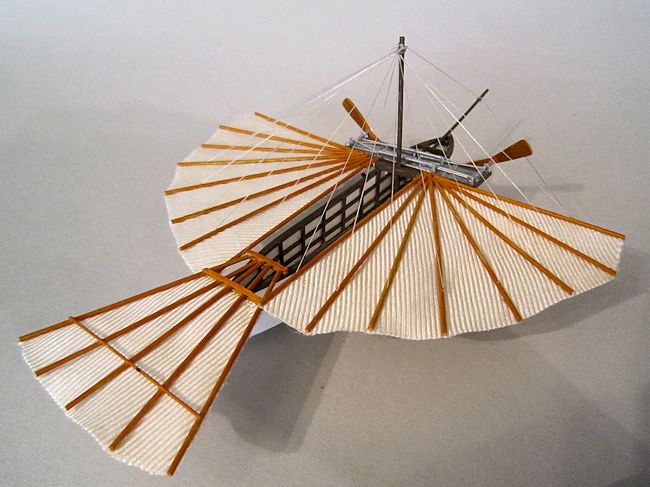 There are even eye witness claims that the Wright brothers were present at
Whitehead's early flights. Something which they later fiercely denied.
If
you feel strongly about this matter, one way or the other, then please do not
write about it to me. I avoid all arguments as they are vulgar and often too
convincing.
There are even eye witness claims that the Wright brothers were present at
Whitehead's early flights. Something which they later fiercely denied.
If
you feel strongly about this matter, one way or the other, then please do not
write about it to me. I avoid all arguments as they are vulgar and often too
convincing.
A replica was built in the 1980s and successfully took to the air under the
guiding hand of actor and aviator Cliff Robertson, which proved that it was at
least airworthy, although it was towed behind a car.
No photographs of the first Whitehead in the air have survived.
Gustave Whitehead was in fact born Gustave Weisskopf in 1874 in Germany. He
emigrated to the US, changed his name by Anglicizing it, and became an aviation
pioneer, building gliders, flying machines and engines between 1897 and 1915.
He claimed that he flew a powered machine successfully several times in 1901 and
1902. His reputation rests on a newspaper article written as an eyewitness
account which stated that Whitehead made a powered flight in Connecticut on 14
August 14, 1901. In later months, details from this article were reprinted in
newspapers around the world.
Whitehead's aircraft designs and experiments also attracted notice in Scientific
American magazine. Whitehead later worked for sponsors who hired him to build
aircraft of their own design, although none flew, and he became a known designer
and builder of lightweight engines. Public notice of his work ended in 1915 and
died in obscurity in 1927.
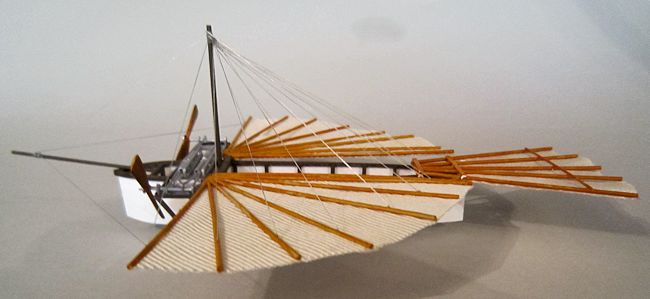 In 1937, a book asserting that Whitehead had made powered flights in 1901-1902
triggered debate in the 1930s and '40s among scholars, and aviation enthusiasts.
Further independent research in the 1960s and 70s, including books in 1966 and
1978, supported the Whitehead claims.
In 1937, a book asserting that Whitehead had made powered flights in 1901-1902
triggered debate in the 1930s and '40s among scholars, and aviation enthusiasts.
Further independent research in the 1960s and 70s, including books in 1966 and
1978, supported the Whitehead claims.
In 2013 Jane's All the World's Aircraft recognized Whitehead as the first to
make a manned, powered, controlled flight. This statement reignited debate over
who flew first. On 26 June, 2013 the state of Connecticut enacted a law which
specifies that "Powered Flight Day" honours the first powered flight by Gustave
Whitehead, rather than the Wright Brothers.
| CONSTRUCTION |
It really is quite a simple scratch build, and went together without any
hitches. The fuselage is a simple boat shape, and indeed the engineering all
round uses ship building technology, combined with wings
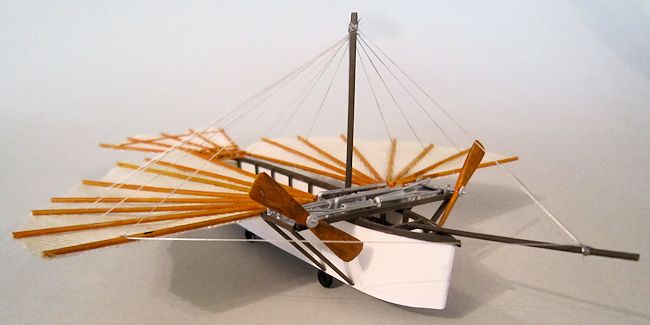 which follow the shape
of the gliders built by Otto Lilienthal.
which follow the shape
of the gliders built by Otto Lilienthal.
A base was cut to shape, and two sides, which are best sprayed white and kept
separate while the internal struts are put in place. Photos of modern replicas
suggest these are simple two by fours, painted dark brown.
They are not even mortise jointed,
but simply screwed in place over each other, which makes construction
easy.
Leave the various masts until later. I now made up the trickiest part which is
the compression engine. There are some good quality close-ups of this on the
various replicas, and I followed these while putting together plastic rod and
tube of various thicknesses. A
crank shaft for each propeller is the only fiddly part, and is made of differing
lengths of rod, with tiny cranks from card.
The engine was powered by acetylene, which I would guess came from a
canister of compressed gas, probably hidden beneath the engine tray.
After that come the wings, which were lengths of bamboo, supporting a silk
“sail” beneath, sewed to the bamboo struts at intervals. Two junction boxes for
the struts were made up from card and tied together with a square section wing
spar in the middle. The struts were lengths of rod, painted a pale yellow brown
for bamboo.
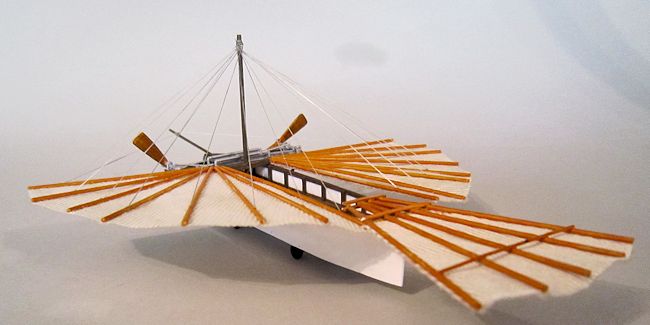 And now the piece de resistance, something which I had never tried before, and
may well come into use on future projects. I had an old white silk opera scarf,
which had been my grandfather's, which he wore while flying in WWI.
It had worn into patches over the years. I had finally found a way of
honouring it. I made a paper
pattern and then carefully cut the silk into shape, using a new sharp scalpel
blade. If you are going to use this method, try to establish which way the grain
of the silk goes, and cut accordingly to avoid too much fraying.
And now the piece de resistance, something which I had never tried before, and
may well come into use on future projects. I had an old white silk opera scarf,
which had been my grandfather's, which he wore while flying in WWI.
It had worn into patches over the years. I had finally found a way of
honouring it. I made a paper
pattern and then carefully cut the silk into shape, using a new sharp scalpel
blade. If you are going to use this method, try to establish which way the grain
of the silk goes, and cut accordingly to avoid too much fraying.
It was then attached to the bamboo struts using Humbrol Clearfix. I imagine any
canopy glue would work well. Small
dabs of superglue gel held any fraying threads in place.
You can allow a little sagging between the struts, as the original shows it was
a fairly makeshift affair.
The same was repeated for the tail feathers. There was no fin on the aircraft,
and changes of direction were effected by the pilot shifting his weight inside
the boat. A technique still used on hang gliders and micro-light aircraft which
have a horizontal bar instead of conventional control stick.
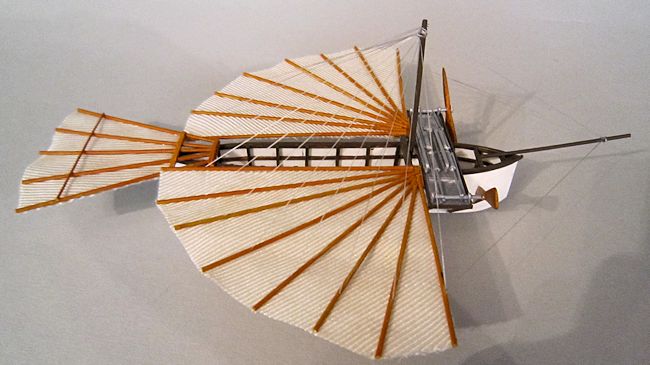 Once the wings are in place, the central mast, or kingpost, can be cemented
between the engine tray and the wing spar. And also the bowsprit, or nose probe
as it has come to be known by aviators. Rig the thing according to plan, using
elastic thread, coloured silver with a gel felt tip pen, and attached by
superglue gel placed with a sharpened toothpick.
Once the wings are in place, the central mast, or kingpost, can be cemented
between the engine tray and the wing spar. And also the bowsprit, or nose probe
as it has come to be known by aviators. Rig the thing according to plan, using
elastic thread, coloured silver with a gel felt tip pen, and attached by
superglue gel placed with a sharpened toothpick.
Then four small wheels were threaded on axles underneath, which are dead
tailwheels from the Big Bag of Wheels. Finally, I cut down the fan shaped props
from an old Corsair propeller, which gave enough surface area to allow the
unusual shape. They had tiny spinners attached, from card and rod. And then
glued to the ends of the crankshafts.
| CONCLUSIONS |
There you have a tribute to what might have been the first ever powered controlled aircraft. Whatever its claims, you have to admire the courage of the man who climbed into it with every expectation that it might become airborne. I don't know about you, but I wouldn't have done it.
| REFERENCES |
http://www.gustave-whitehead.com/
http://www.flyingmachines.org/gwhtd.html
http://www.ctpost.com/local/article/Aviation-bible-Whitehead-first-to-fly-4348050.php
July 2014
If you would like your product reviewed fairly and quickly, please contact the editor or see other details in the Note to Contributors.